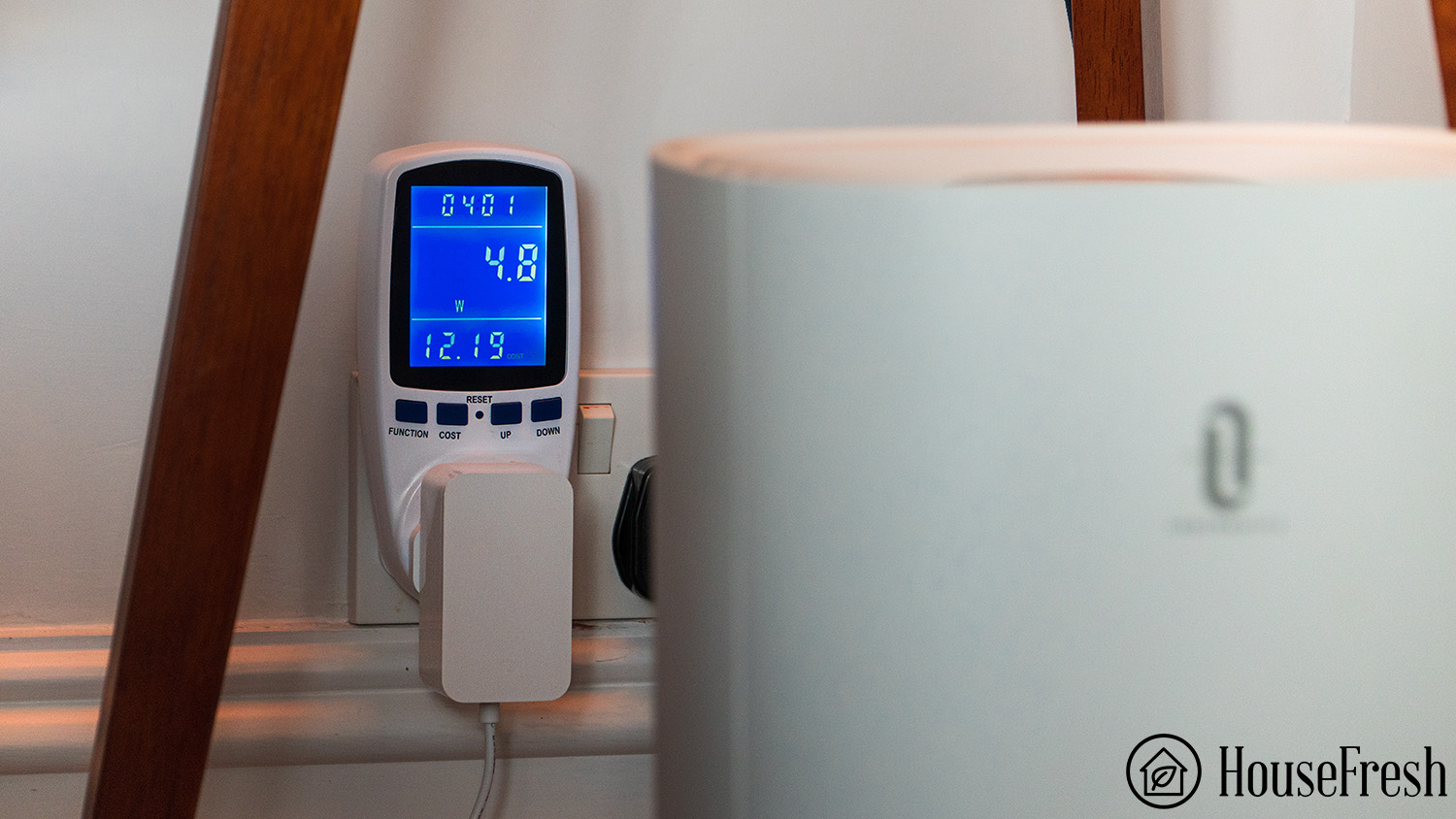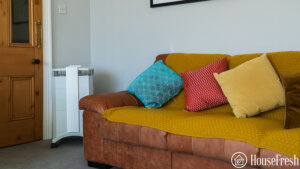The Corsi–Rosenthal Box is the brainchild of Dr. Richard Corsi and Jim Rosenthal and it was developed to create an affordable and effective DIY air cleaner during the COVID-19 pandemic. It was designed to use common MERV-13 HVAC filters (that are easily available in the United States) in combination with a box fan. Unlike the other devices we have reviewed here at HouseFresh, it is an air purifier that you can build yourself.
After recent controversy around the use of the term ‘CR Box’ to refer to variations of the DIY filter and fan box, it is worth mentioning that the Corsi–Rosenthal Box was an improvement on the DIY box fan air purifiers that have been around for many years.
The Corsi-Rosenthal Box is sometimes referred to as the Comparetto Cube. The main difference between the two is that the CR-Box uses five MERV-13 filters, whereas the Comparetto Cube uses four filters with the bottom side covered by cardboard. Rosenthal devised a further improvement by adding a “fan shroud” made of cardboard to cover the corners of the box fan, improving its performance.
Most CR Boxes you will see these days doing the rounds on Reddit or X (formerly Twitter) are what could be called Corsi-Rosenthal Boxes with a Comparetto Cube configuration.
Several studies have supported the effectiveness of the Corsi–Rosenthal Box, including research by the EPA, which tested the device and showed it could be very effective at removing the tiniest particles of 0.01 µm – 0.6 µm. A study from researchers at Brown University also showed that a Corsi–Rosenthal Box can help reduce PFAS and phthalate levels, which are common indoor air pollutants. The Corsi–Rosenthal Box was also tested by researchers at UC Davis Energy and Efficiency Institute, who found that this DIY device performs similarly to residential portable air purifiers in terms of estimated clean air delivered, even though it costs about three times less.
As this concept aligns with our core mission of helping deliver clean air, affordable for all, we were keen to build our own Corsi-Rosenthal Box with a Comparetto Cube configuration.
But we didn’t stop there. We also tested the Corsi–Rosenthal Box following the exact same process we followed with every other air purifier we have reviewed to date so we could compare its performance like-for-like.
- In our home lab of 728 cubic feet, we light an incense stick to generate particle pollution and VOCs.
- We set up our trusted Purpleair Indoor Sensor with the latest Bosch gas sensor to track levels of PM1ug/m3, PM2.5ug/m3 and PM10ug/m3 and VOCs in the air.

- We switch the air purifier to its highest speed and measure how long it takes to get our room air quality down to PM1 level to 0.
- We use an energy meter to measure precisely how much electricity is used when running the unit at the lowest and highest fan speed settings.

- We track sound levels emitted by the air purifier at different fan speeds with the help of a commercial sound meter.

Read more about our testing process and feel free to get in touch if you have any questions.
The lowdown on the Corsi–Rosenthal Box


If you don’t have time to read the full review, you can just read my top-line summary of the findings when testing the CR Box:
What we really like
What we think could be better
The specifications
Considering you can build this air purifier yourself, the fact that our CR Box managed to clean the air as fast as pricey shop-bought devices is impressive.
| HouseFresh rating: | ★★★★★ |
| Time to clean our 728 cubic feet test room (with the device running at top speed): | 25 minutes |
| Air purifier technology: | MERV 13 |
| Recommended room size (4.8 air changes per hour): | 680 sq. ft. |
| Clean air delivery rate (CADR): | Estimated: 274 CFM |
| Dimensions (in inches / in cm): | 20L x 20W x 20H inches (50L x 50W x 50H cm) |
| Weight (in pounds / in kg): | 10 lbs (4.5 kg) |
| Filter life: | 6-12 months |
| Noise level in decibels (measured from 3 ft. away with a sound level meter): | Speed 1: 49 dB Speed 2: 55.1 dB Speed 3: 60.7 dB |
| Electricity consumption in watts (recorded with an electricity usage monitor): | Standby mode: 0 kWh Speed 1: 40.5 kWh Speed 2: 44.5 kWh Speed 3: 46.7 kWh |
| Estimated running cost (electricity consumption + official filter replacement): | $106.46 per year |
| Cost per CADR cfm (based on dust CFM as reported by AHAM): | $0.29 |
| Manufacturer’s warranty: | n/a |
| Country of manufacture: | China |
A bulkier design compared to shop-bought units
The final look will depend on how good you are at handling duct tape — I’m not great.

There is no escaping that this is a box fan with a bunch of HVAC filters taped to it.
Compared to a shop-bought unit, the Corsi–Rosenthal Box is fairly utilitarian, and if you are not very crafty (like me), it can look a little messy.

Something to keep in mind as well is that, due to the design, the Corsi–Rosenthal Box takes up quite a bit of floor space — you can get a better performance-to-size ratio from retail units.
Naturally, you won’t find a fancy control panel with a touchscreen display or hi-tech buttons.

Personally, I love the simplicity of the controls in our CR Box as you will only need to focus on the dial of the box fan – simply adjust the fan speed to match the air cleaning power you need.
All this to say, if you are looking for a stylish unit, then the Corsi–Rosenthal Box might not be the air purifier for you. Just to make my point clear, I asked Teddy to take a comparison shot with the Levoit EverestAir.

Now, this is a completely unfair comparison as the EverestAir is the best-looking air purifier we have tested in 2023. But it helps show how big the Corsi–Rosenthal Box is because the EverestAir is not small.
A great example of why HEPA is not a requirement for clean air
The Corsi–Rosenthal Box uses four MERV 13 filters, and they work like a charm.

HEPA H13 is regularly touted as an important aspect of an air purifier, but the Corsi–Rosenthal Box can clean even the tiniest of particles with MERV-13. This goes to show that HEPA grade is not an absolute requirement for clean air.
Jim Rosenthal regularly discusses that it’s all about filter, fit and flow.
A Corsi–Rosenthal Box can move A LOT of air through each of the four MERV-13 filters. This means that this device can continue to remove even the tiniest of particles as the air passes through the filters multiple times.

Another way to explain this is by sharing my experience when testing small air purifiers that use HEPA H13 filters, but that fail to clean the air in our test room — hello, AROEVE MK01. The reason this happens is that these small air purifiers cannot push enough air through the filters quickly enough to make a meaningful difference to indoor air quality, no matter how high the grade of its HEPA filter.
When building your own CR Box, you need to make sure that you use at least MERV 13, as tests with lower-grade filters have shown to be less effective. Unlike a retail air purifier, you can use any MERV 13 HVAC filter brand.

When the time comes for you to replace the filters in your CR Box, you will need to remove the duct tape around the filters before you can replace them. The last step will be for you to re-tape the new filters.
I am looking forward to the moment when I need to replace the filters in our CR Box so I can ask my wife to help me do a better job at re-retaping them — V2 will look a lot tidier!
The Corsi–Rosenthal Box cleared our test room in 25 minutes
I am blown away by the performance of an air purifier you can put together in 10 minutes with materials that will cost you $50.

We tested the Corsi–Rosenthal Box in the same test room where we test all the air purifiers we review. Our test room measures 728 cubic feet, and we use the PurpleAir PA-II that can track PM1.0ug/m3, PM2.5ug/m3 and PM10.0 ug/m3 and VOCs using the additional Bosch gas sensor.
We lit an incense stick to simulate indoor pollution and then tracked how long it took the Corsi–Rosenthal Box to clean the air to the point that the PurpleAir sensor was showing zero PM1.0ug/m3.
Air cleaning performance test results
Taking just 25 minutes to remove all PM1 particles, the Corsi–Rosenthal Box compared very favorably to much costlier retail devices.
It cleaned the air as fast as the $900 IQAir Healthpro Plus and was 1 minute faster than the large Honeywell HPA300. However, we found it to be 4 minutes slower than the latest budget-friendly purifier from Levoit, the Vital 200S.
Noise levels test results
Noise is a concern for any air cleaner as it must run consistently to be effective. If a device is too loud, then it will not be used as often. That is why we used a sound level monitor to measure how much noise the Corsi–Rosenthal Box generated when running at different fan speed levels.

Creating 54dB at its highest speed, the Corsi–Rosenthal Box makes similar volumes to many commercially available devices but is higher than what we see with premium-priced units like the Smart Blast Mini or Alen BreatheSmart 75i, which manage to limit sound levels to 49 dB at their highest speed.
Now, I know that noise can be very subjective, so after our performance test was complete, we recorded a video of our CR Box running at each fan speed.
The cost to run a Corsi–Rosenthal Box: $106.46 per year
1. Electricity costs = $52.56 per year
I plugged our Corsi–Rosenthal Box through an electricity usage monitor to record how many watts it pulled when running at different fan speeds. For the sake of this calculation, I am using the readings from the top speed.
When running at the highest fan speed, we saw that our CR Box pulled 50.1 watts, which adds $52.56 to your electricity bill if you use it 24 hours per day.
2. Filter costs = $53.90 per year.
Filter replacement will depend on how much use your CR Box and how dirty the air is in your specific location, but a good rule of thumb is to replace your filters every 6-12 months.
Assuming the filter achieves a 12-month lifespan, you can get a new set of 4 filters every year for $53.90
- Nominal size: 20x20x1; Actual size: 19 3/4"x 19 3/4" x 3/4"; This MERV 13 filter is comparable with MPR 1500-1900 & FPR 10
- Designed to filter microscopic particles such as lint, dust mites, spores, pollen, pet dander, fine dust, smoke, viruses, and bacteria
- Simple to install and a cost-effective step towards a healthier home environment. For best results, change your filters every 60 to 90 days but increase frequency to 30 days during peak summer and winter months
- 100% synthetic electrostatic media for high efficiency with low air flow resistance
- Manufactured by Filtration Group, a world-leading manufacturer and supplier of filtration solutions making the world safer, healthier & more productive
If you spot visible dirt on the filters, don’t panic, as it doesn’t mean your MERV-13 filters need to be replaced. Tests have shown that a Corsi–Rosenthal Box will still clean the air even if the filters “look” dirty.
You should wait till the soiling is noticeable or if you feel the CR box is not as effective following AQI sensor metrics.
Bottom line
Powerful air cleaning performance for $50 and some duct tape!
Many air purifier brands like to overstate how complicated it is to clean the air, but the Corsi–Rosenthal Box is living proof that you just need a fan and filter — literally.
Thanks to the support and knowledge of the clean air community, we can now clean the air in our homes with easily available parts that won’t require much time or money. Who knows, you may even have the required components lying around your house already!

While I still think that a specially designed air purifier will make more sense to people who can invest in the right unit for the specific job they need, the Corsi–Rosenthal Box is perfect for those on a tight budget or who need to deal with an unexpected (and serious) indoor air quality problem like wildfire smoke or another pandemic from an airborne virus.
It might be hard for you to trust me when I tell you that a fan, a bunch of HVAC filters and some duct tape are all you need to clean the air in your home. In fact, this might be the first time you hear about the Corsi-Rosenthal Box.
In the age of big newspapers and magazines recommending the best air purifiers to their readers, you won’t see many big media companies talking about the Corsi–Rosenthal Box.

The reason none of these publications are recommending the Corsi-Rosenthal Box is that having you build your own air purifier won’t help them boost their bottom line. But here at HouseFresh, we think it’s important to help you breathe clean air, even if that won’t make us rich. We wouldn’t be serious about what we do if we hadn’t taught you how to build a DIY air purifier or if we weren’t spreading the word about how AWESOME the CR Box is.
If you have any questions about the Corsi–Rosenthal Box, shoot me an email at danny@housfresh.com, and I’ll try to help. In the meantime, here is a step-by-step guide on how to build your own CR Box:
There are many people from the COVID-Aware and clean air communities, who are constantly innovating in the search for cost-effective air cleaners that will perform as well as shop-bought devices. I will continue to test and review these devices under the same conditions in which we test branded units, so you can decide what is best for you.
Stay tuned, as we are currently on the waiting list to buy the Nukit Tempest so we can test it. This is another promising DIY air purifier that comes with a metal frame designed to house PC fans instead of the usual box fans, which can greatly reduce the noise generated when the device is doing its work. Exciting stuff!
SOURCES
We calculated energy consumption costs with the help of the Department of Energy’s appliance energy calculator. We calculated yearly costs associated with running the Corsi–Rosenthal Box for 24hs a day for 365 days. We ran this calculation utilizing the U.S. average utility rate of $0.12/kWh as of December 20, 2023.
Last update on 2024-04-26 / Affiliate links / Images from Amazon Product Advertising API





